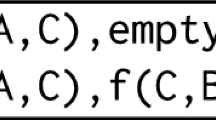Abstract
This paper describes LPMEME, a new learning algorithm for inductive logic programming that uses statistical techniques to find first-order patterns. LPMEME takes as input examples in the form of logical facts and outputs a first-order theory that is represented to some degree in all of the examples. LPMEME uses an underlying statistical model whose parameters are learned using expectation maximization, an iterative gradient descent method for maximum likelihood parameter estimation. The underlying statistical model is described and the EM algorithm developed. Experimental tests show that LPMEME can learn first-order concepts and can be used to find approximate solutions to the subgraph isomorphism problem.
Preview
Unable to display preview. Download preview PDF.
Similar content being viewed by others
References
John Allen and Kevin Thompson. Probabilistic concept formation in relational domains. In Proceedings of the Eighth International Workshop on Machine Learning, pages 375–379, 1991.
Peter Artymiuk, Helen Gridley, Andrew Poirrette, David Rice, Elizabeth Ujah, and Peter Willett. Identification of β-sheet motifs, of ψ-loops, and of patterns of amino acid residues in three-dimensional protein structures using a subgraph-isomorphism algorithm. Journal of Chemical Information and Computer Sciences, 34(1):54–62, Jan-Feb 1994.
Timothy L. Bailey and Charles Elkan. Fitting a mixture model by expectation maximization to discover motifs in biopolymers. In Proceedings of the Second International Conference on Intelligent Systems for Molecular Biology (ISMB'94), pages 28–36, Aug 1994.
Clifford Brunk and Michael Pazzani. An investigation of noise-tolerant relational concept learning algorithms. In Proceedings of the Eighth International Workshop on Machine Learning, pages 389–393, 1991.
A.P. Dempster, N.M. Laird, and D.B. Rubin. Maximum likelihood from incomplete data via the EM algorithm. Journal of the Royal Statistical Society, 36:1–21, 1976.
Richard Duda and Peter Hart. Pattern Classification and Scene Analysis. John Wiley & Sons, Inc., 1973.
Michael Garey and David Johnson. Computers and Intractability: A Guide to the Theory of NP-Completeness. Freeman and Company, 1979.
Steven Muggleton. Inductive logic programming. New Generation Computing, 8:21–33, 1991.
Steven Muggleton. Inductive logic programming: Derivations, successes and shortcomings. In Proceedings of the Tenth International Conference on Machine Learning, pages 21–33, 1993.
J.R. Quinlan. Induction of decision trees. Machine Learning, 1(1):81–106, 1986.
J.R. Quinlan. Learning logical definitions from relations. Machine Learning, 5(3):239–66, 1990.
J.R. Quinlan. FOIL: A midterm report. In Proceedings of the Tenth International Conference on Machine Learning, pages 3–19, 1993.
Michael Sternberg, Ross King, Richard Lewis, and Steven Muggleton. Application of machine learning to structural molecular biology. Phil. Trans. R. Soc. Land. B, 344:365–71, 1994.
Wen-Hsiang Tsai and King-Sun Fu. Subgraph error-correcting isomorphisms for syntactic pattern recognition. IEEE Trans. on Systems, Man, and Cybernetics, 13(1):48–62, Jan-Feb 1983.
Jason Wang, Gung-Wei Chirn, Thomas Marr, Bruce Shapiro, Dennis Shasha, and Kaizhong Zhang. Combinatorial pattern discovery for scientific data: Some preliminary results. In 1994 ACM SIGMOD International Conference on Management of Data, pages 115–125, 1994.
Author information
Authors and Affiliations
Editor information
Rights and permissions
Copyright information
© 1996 Springer-Verlag Berlin Heidelberg
About this paper
Cite this paper
Bhatia, K., Elkan, C. (1996). LPMEME: A statistical method for inductive logic programming. In: McCalla, G. (eds) Advances in Artifical Intelligence. Canadian AI 1996. Lecture Notes in Computer Science, vol 1081. Springer, Berlin, Heidelberg. https://doi.org/10.1007/3-540-61291-2_54
Download citation
DOI: https://doi.org/10.1007/3-540-61291-2_54
Published:
Publisher Name: Springer, Berlin, Heidelberg
Print ISBN: 978-3-540-61291-9
Online ISBN: 978-3-540-68450-3
eBook Packages: Springer Book Archive



